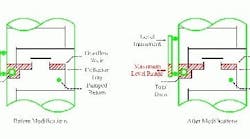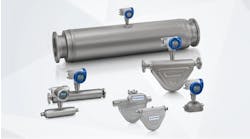A delayed coking unit suffered from wide variations in liquid rate in its major distillation column. The unit operated on a cycle, as two upstream thermal-cracking reactors (the coke drums) switched into and out of service as their drums filled with coke and then were emptied. During the drum switch, net product rate sometimes could fall to close to zero. In situations where product rate dramatically changes, one way to provide control margin is to maintain a liquid inventory to cushion the control system.
Figure 1 shows before and after modifications to the level instrument on the delayed-coker main-fractionator stream to increase the operating liquid cushion. At least, that was the intention. The results were a bit different.
Figure 1. Changing the position of the level instruments top nozzle increased its span and only that. (Click to enlarge.)
Relocating the upper-level nozzle on the tower has increased the level-instrument span. However, the actual liquid volume inside the tower remains the same; so, the residence time available is unchanged. Instruments measure a physical object, they dont create it.
Not surprisingly, after startup, no improvement was realized. Yet, the tower ran with the new level bridle and no other modifications for more than a decade. Then, in talking with operators about other problems, one operator complained to me that a major part of the units difficulty stemmed from inability to control unit levels and heat balance during the drum switch. A quick check showed that the operator was completely correct the useable level span was too short even though the instrument appeared to have enough range.
Figure 2 shows the appropriate modification installing a deeper collector tray to actually increase the liquid range. This requires removal of existing trays. However, for this service, overall unit performance can be maintained by using structured packing in place of trays above the draw, because the structured packing offers greater efficiency (i.e., less height for a theoretical plate).
Figure 2. Installing a deeper collector tray was essential for actually providing greater liquid range.
Always take care that the process will allow new instrumentation to work. If your process doesnt have the inherent capability (liquid volume in this case) to meet operating requirements, even the best instrumentation wont do the job.


